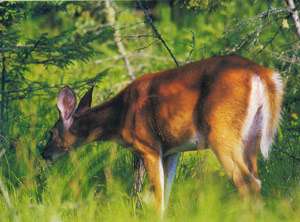In last summer’s Discoveries, we reported that overly abundant white-tailed deer are inflicting great damage on forest understory plants, like ginseng. What are the implications of a forest bereft of forest-floor plants, including many other wildflowers? The problem begins with the reduction in forest floor abundance and diversity but then is magnified up the food web whose foundation is understory plants and whose higher levels include invertebrates, such as insects and snails, and their predators, including many of our familiar songbirds.
Sylvain Allombert and his colleagues from the Center for Functional Evolution and Biology in Montpellier, France, have been studying this phenomenon at a research site on a group of islands in British Columbia, home to a relative of our native whitetail, the Sitka black-tailed deer (Odocoileus hemionus sitkensis). In two separate papers in 2005, Allombert et al. reported on the impacts that deer browsing had on two distinct trophic levels: invertebrates and birds.
The researchers were fortunate to have a laboratory seemingly set up for the study: certain of the islands in the archipelago had hosted deer for over 50 years, while others had them for less than 20 years and some never had deer. They collected invertebrates (including bees, other insects, beetles, and spiders) in three different habitat types on each kind of island: leaf litter in the forest interior; vegetation lower than the level deer can browse in the forest interior; and vegetation lower than the deer-browse line at the forest edge.
They found that at the forest’s edge, the longer deer had been present on an island, the less diverse and abundant the invertebrate population. In the heart of the forest and especially at forest edges, invertebrate populations were significantly reduced only on islands that had been home to deer for more than 50 years. Leaf litter populations were not significantly affected regardless of deer-browse history. These results suggest that deer browsing has a significant impact on insects that rely on forest understory vegetation and that this relationship is exacerbated at forest edges and in places where deer have been browsing for many years.
It seems logical that when insects become fewer and less diverse, so do their predators, including songbirds, which is what Allombert and his team studied next. They sampled bird populations on each of the six islands where invertebrates were studied and reviewed relevant data from a larger set of 31 islands. They found that songbird abundance decreased most on islands where deer had been browsing the longest, and that birds that rely on understory vegetation for food, shelter, and nesting (like warblers and woodpeckers) suffered the greatest reduction.
In our own region, with a burgeoning deer population and noticeable declines in songbird populations (also attributable to environmental changes including climate change, acid rain, and habitat loss), these studies shed new light on the complex relationships that take place in the forest, where deer are estimated to exceed the capacity of the ecosystem to support them in 73 percent of their range. This outpacing of carrying capacity, write Allombert and colleagues, “when put together with results from this and previous studies, underline[s] the potential role of deer abundance as a factor explaining negative population trends in forest songbirds, a role probably still underestimated.”


